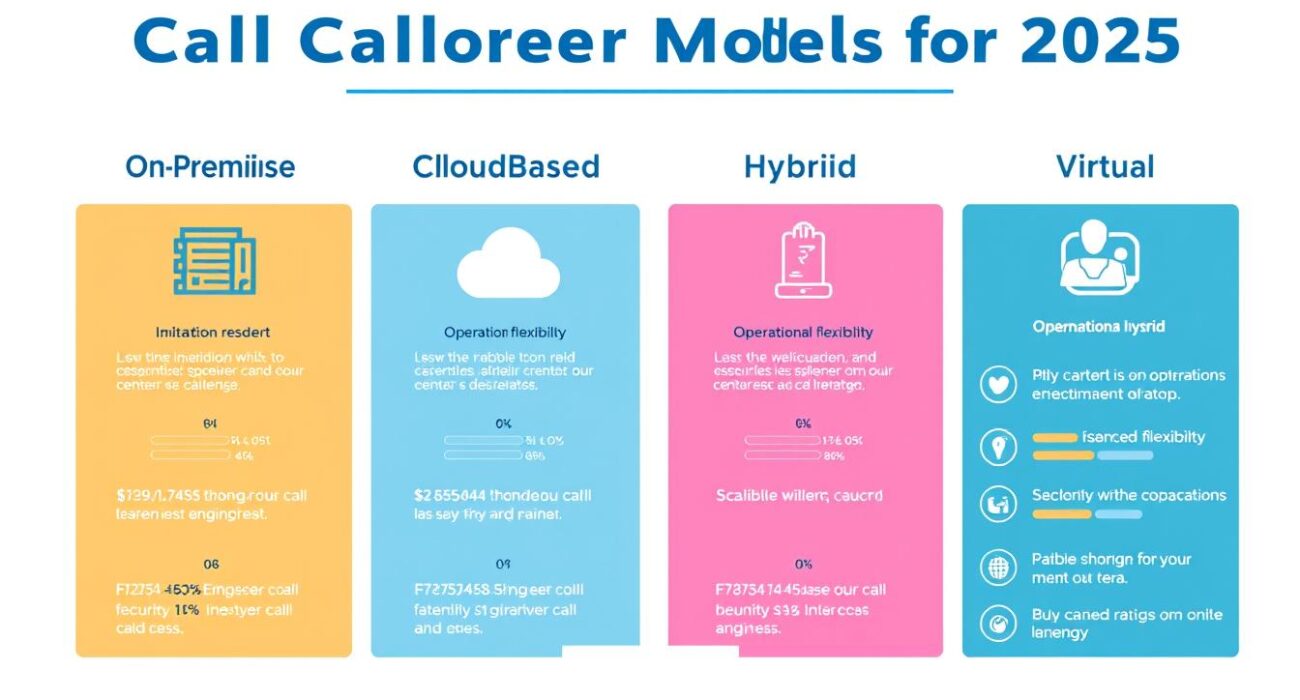Think of your call center as a digital command center—one that needs to be equipped not just for today’s challenges but for tomorrow’s opportunities. With AI-driven analytics, hybrid workforce models, and sustainability requirements becoming standard, the traditional call center model is transforming into something more agile, efficient, and customer-centric.
Planning Your Call Center Setup 2025: Essential First Steps
Before diving into equipment purchases or hiring staff, you need a solid foundation for your call center. The planning phase is critical for aligning your call center with both current market demands and future trends.
Determine Your Call Center Model
The first decision in your call center setup 2025 journey is choosing between different operational models, each with distinct advantages:
On-Premise Call Center
- Complete control over infrastructure
- Enhanced security for sensitive data
- Direct supervision of staff
- Higher initial investment
- Limited geographical talent pool
Cloud-Based Call Center
- Reduced infrastructure costs
- Rapid deployment capabilities
- Built-in scalability
- Enhanced disaster recovery
- Automatic software updates
Hybrid Call Center
- Flexibility to combine on-site and remote operations
- Balanced approach to security and accessibility
- Adaptable to changing business needs
- Gradual transition capability
- Optimized resource allocation
Virtual Call Center
- Fully remote workforce
- Minimal physical infrastructure
- Access to global talent pool
- Reduced overhead costs
- Enhanced business continuity
Comparison of call center models for 2025: evaluating cost, flexibility, and scalability factors
When Sarah launched her eco-friendly call center in 2024, she opted for a hybrid model that allowed her to maintain a small physical hub while employing remote agents across three time zones. This approach reduced her carbon footprint by 40% compared to a traditional setup while expanding her talent pool significantly.
Define Your Call Center’s Focus and Scope
Your call center’s purpose will dictate its structure, technology requirements, and staffing needs:
Inbound Call Center
- Customer support and service
- Order processing
- Technical assistance
- Appointment scheduling
- Information requests
Outbound Call Center
- Sales and telemarketing
- Market research
- Lead generation
- Customer follow-ups
- Debt collection
Omnichannel Contact Center
- Voice calls
- Email support
- Live chat
- Social media engagement
- Video support
Ready to Map Out Your Call Center Journey?
Get our detailed planning worksheet to document your call center model, focus areas, and initial requirements. This foundational document will guide your entire setup process.
Essential Technology Infrastructure for Call Center Setup 2025
The technological backbone of your call center will determine its efficiency, scalability, and competitive edge. In 2025, several key technologies have become standard for forward-thinking call centers.
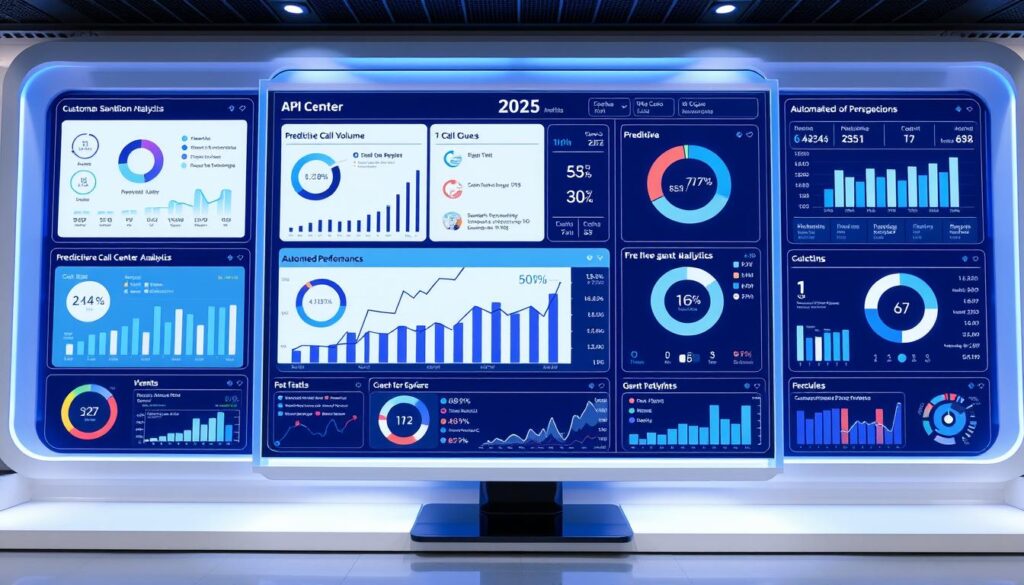
Next-generation AI-powered call center dashboard with real-time analytics and agent performance metrics
Cloud-Based Contact Center Platform
The foundation of any modern call center setup 2025 is a robust cloud-based platform that offers flexibility, scalability, and integration capabilities:
- Automatic Call Distribution (ACD): Routes calls to the most appropriate agent based on skills, availability, and customer needs
- Interactive Voice Response (IVR): Provides self-service options and intelligent routing based on customer inputs
- Omnichannel Capabilities: Seamlessly integrates voice, email, chat, SMS, and social media interactions
- Workforce Management: Optimizes scheduling, forecasting, and agent productivity
- CRM Integration: Connects customer data across platforms for personalized service
“By 2025, cloud-based contact center platforms will handle over 75% of all customer interactions, with AI-augmented capabilities becoming the standard rather than the exception.”
AI and Automation Technologies
Artificial intelligence has transformed from a luxury to a necessity in call center operations:
Conversational AI
- Natural language processing for understanding customer intent
- Sentiment analysis to gauge customer emotions
- Virtual assistants for handling routine inquiries
- Real-time translation for global customer base
Predictive Analytics
- Call volume forecasting for optimal staffing
- Customer behavior prediction
- Proactive issue identification
- Performance trend analysis
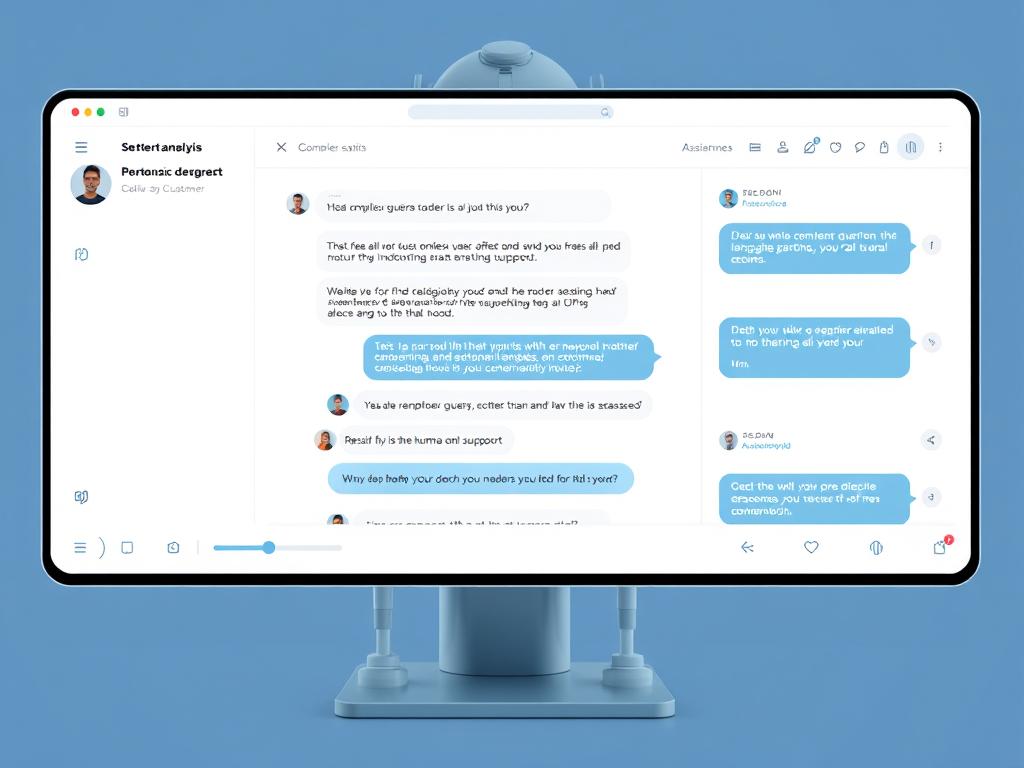
Advanced AI chatbot interface with natural language processing and sentiment analysis capabilities
Security and Compliance Technology
With increasing regulatory requirements and cyber threats, security infrastructure is non-negotiable:
- Biometric Authentication: Voice recognition and other biometric verification methods
- End-to-End Encryption: Secure transmission of customer data across all channels
- Automated Compliance Monitoring: Real-time checks for regulatory adherence
- Secure Payment Processing: PCI-DSS compliant transaction handling
- Data Loss Prevention: Systems to prevent unauthorized data access or transfer
Build Your 2025 Call Center Tech Stack
Access our comprehensive technology evaluation matrix to compare leading platforms and solutions for your specific call center needs.
Staffing and Training for Your Call Center Setup 2025
The human element remains crucial even as technology advances. Your agents will need new skills to thrive in the AI-augmented environment of 2025.

Modern call center staffing combines on-site and remote agents in a collaborative environment
The Evolving Role of Call Center Agents
In 2025, call center agents are no longer just phone operators—they’re customer experience specialists who work alongside AI:
Traditional Agent Skills
- Clear communication
- Problem-solving abilities
- Product knowledge
- Patience and empathy
- Time management
2025 Agent Skills
- AI collaboration and oversight
- Data interpretation
- Complex issue resolution
- Omnichannel proficiency
- Emotional intelligence
Recruitment Strategies for the Modern Call Center
Finding the right talent requires a strategic approach:
- Skills-Based Hiring: Focus on adaptability and technological aptitude over traditional call center experience
- Global Talent Pool: Leverage remote work capabilities to access diverse talent worldwide
- AI-Assisted Recruitment: Use predictive analytics to identify candidates likely to succeed
- Diversity and Inclusion: Build teams that reflect your customer base for better understanding and service
- Gig Economy Integration: Consider flexible staffing models for peak periods

Immersive VR training programs help agents develop complex problem-solving skills
Innovative Training Approaches
Preparing agents for the 2025 landscape requires advanced training methodologies:
- Immersive Learning: VR/AR simulations of customer interactions
- AI-Powered Coaching: Real-time guidance and feedback during calls
- Microlearning: Bite-sized, continuous training modules
- Gamification: Competitive elements to boost engagement and retention
- Cross-Channel Training: Ensuring proficiency across all communication channels
| Training Component | Traditional Approach | 2025 Approach | Expected Outcome |
| Onboarding | 2-week classroom training | Blended learning with VR simulations | 40% faster proficiency |
| Product Knowledge | Manual and documentation review | Interactive knowledge base with AI assistance | 90% information retention |
| Soft Skills | Role-playing exercises | Emotion recognition AI feedback | 35% improvement in customer satisfaction |
| Performance Review | Monthly supervisor evaluation | Continuous AI-powered coaching | 60% reduction in performance gaps |
Elevate Your Agent Training Program
Get our comprehensive training curriculum template designed specifically for 2025 call center requirements, including AI collaboration modules and virtual reality scenarios.
Operational Processes for Efficient Call Center Setup 2025
Streamlined processes are the backbone of an efficient call center. In 2025, these processes must balance automation with human oversight.
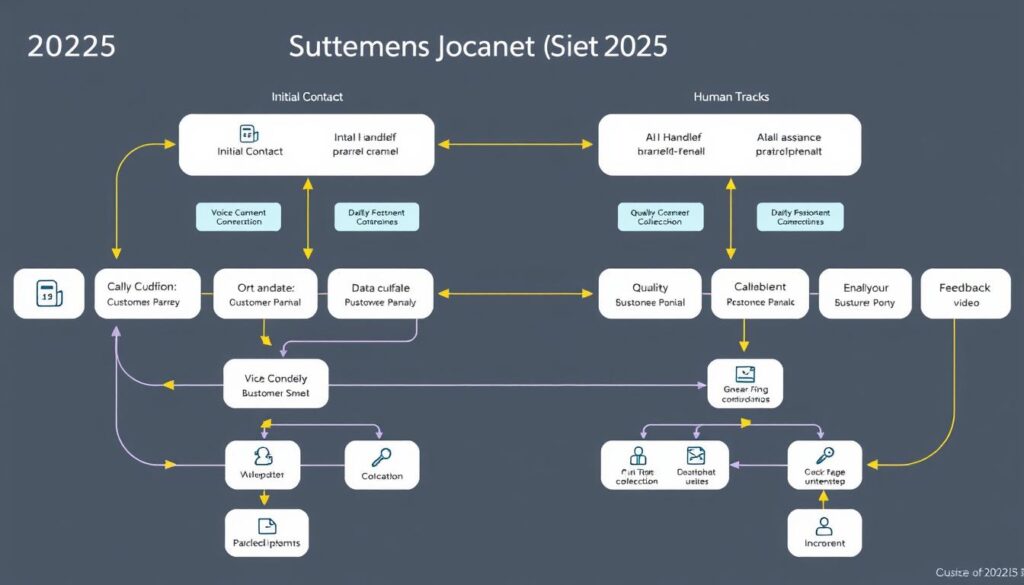
Automated workflow processes integrate AI and human touchpoints for seamless customer journeys
Call Routing and Queue Management
Intelligent routing ensures customers reach the right resource quickly:
- AI-Powered Intent Recognition: Routes based on the true purpose of the call, not just menu selections
- Skills-Based Routing: Matches customers with agents who have the specific expertise needed
- Priority Queuing: Identifies high-value or urgent cases for expedited handling
- Callback Options: Allows customers to maintain their place in queue without waiting on the line
- Channel Pivoting: Seamlessly transfers interactions between channels based on complexity
Quality Assurance and Performance Management
Maintaining service excellence requires robust monitoring and improvement systems:
Automated QA
- 100% call analysis through AI
- Script adherence monitoring
- Compliance verification
- Sentiment tracking
- Automated scoring
Performance Optimization
- Real-time agent guidance
- Personalized coaching alerts
- Predictive performance metrics
- Gamified improvement targets
- Peer benchmarking
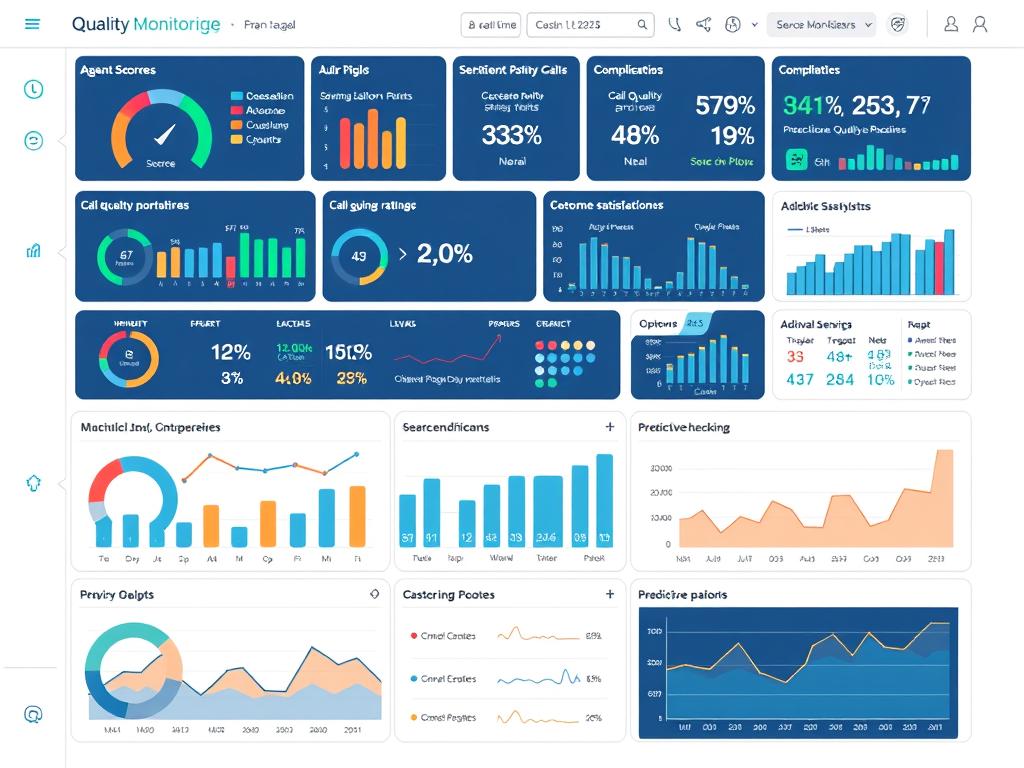
Real-time quality monitoring dashboards provide instant feedback on agent performance and call quality
Knowledge Management Systems
Effective information access is critical for quick resolution:
- AI-Powered Knowledge Base: Self-learning system that improves with usage
- Contextual Information Delivery: Provides agents with relevant information based on the current conversation
- Visual Guidance Tools: Step-by-step visual instructions for complex processes
- Collaborative Knowledge Creation: Agent contributions to improve and update information
- Customer-Facing Knowledge Portals: Self-service options that reduce call volume
Optimize Your Call Center Workflows
Download our process optimization toolkit with customizable workflow templates, KPI dashboards, and quality assurance frameworks designed for 2025 call centers.
2025 Compliance and Security Requirements for Call Centers
Regulatory requirements for call centers have evolved significantly by 2025, with increased focus on data protection, privacy, and sustainability.
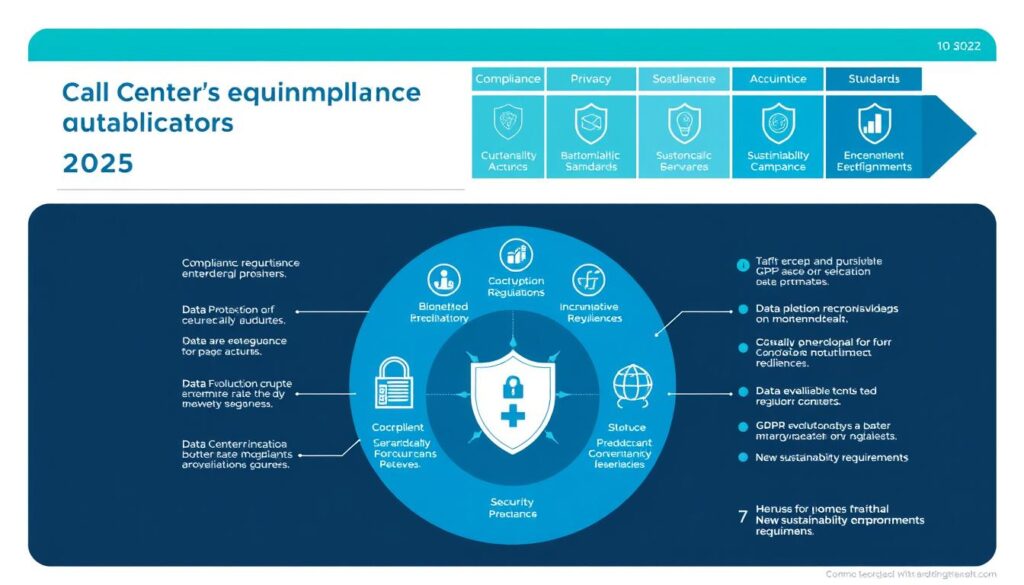
Comprehensive compliance framework addressing data protection, privacy, and sustainability requirements
Data Protection and Privacy Regulations
By 2025, global privacy regulations have become more stringent and unified:
- Enhanced GDPR and CCPA: Expanded versions of existing regulations with stricter enforcement
- Biometric Data Protection: Specific rules for voice prints and other biometric identifiers
- AI Transparency Requirements: Mandatory disclosure when customers interact with AI
- Right to Human Intervention: Customer right to request human agent at any point
- Cross-Border Data Compliance: Navigation of complex international data sovereignty laws
2025 Compliance Checklist
- Implement AI ethics framework and governance
- Establish data minimization and retention policies
- Deploy automated compliance monitoring systems
- Conduct quarterly privacy impact assessments
- Maintain comprehensive data processing records
- Implement carbon footprint tracking and reporting
Security Infrastructure Requirements
Security standards have evolved to address sophisticated threats:
Authentication and Access
- Multi-factor authentication
- Zero-trust architecture
- Continuous identity verification
- Role-based access controls
- Privileged access management
Threat Protection
- AI-powered threat detection
- Real-time vulnerability scanning
- Automated patch management
- Secure remote access protocols
- Advanced social engineering defense

Advanced security operations centers provide 24/7 monitoring of call center infrastructure
Sustainability and Corporate Responsibility
Environmental considerations have become regulatory requirements:
- Carbon Footprint Reporting: Mandatory tracking and disclosure of emissions
- Energy Efficiency Standards: Requirements for green infrastructure and operations
- E-Waste Management: Certified recycling programs for technology equipment
- Remote Work Carbon Credits: Incentives for reducing commuter emissions
- Sustainable Supply Chain: Verification of vendor environmental practices
Stay Compliant in 2025 and Beyond
Our comprehensive compliance guide includes regulatory updates, implementation checklists, and audit preparation tools specifically for call center operations.
Budget Planning for Call Center Setup 2025
Understanding the financial implications of modern call center operations is essential for sustainable growth. Cost structures have evolved significantly with new technologies and operational models.
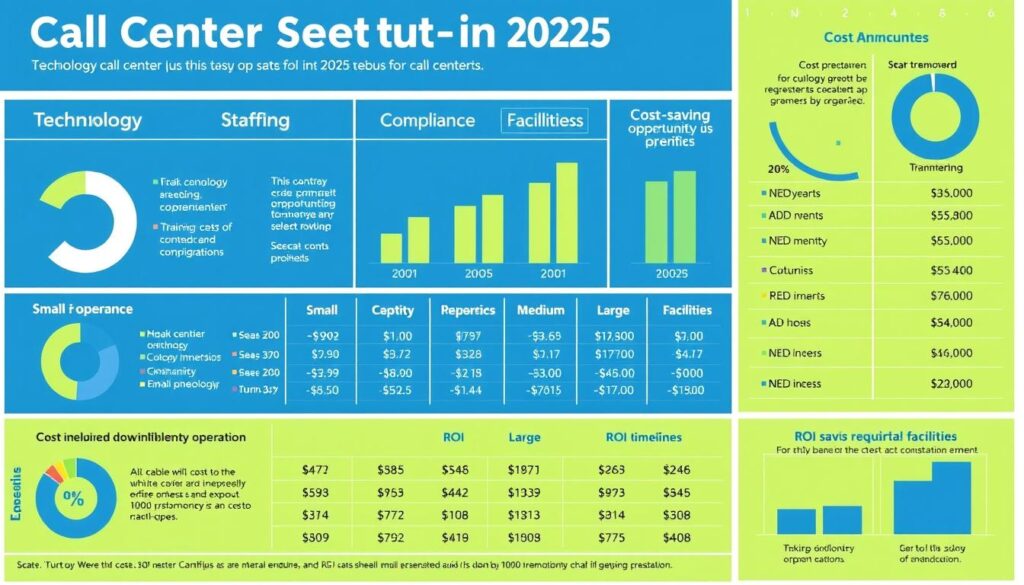
Comprehensive cost breakdown for different call center models and scales in 2025
Initial Setup Costs
Startup expenses vary significantly based on your chosen model:
| Expense Category | Traditional Model | Cloud-Based Model | Hybrid Model |
| Technology Infrastructure | $150,000-$300,000 | $50,000-$100,000 | $75,000-$150,000 |
| Facility Setup | $80,000-$200,000 | $10,000-$30,000 | $40,000-$100,000 |
| Training Systems | $30,000-$60,000 | $15,000-$40,000 | $20,000-$50,000 |
| Compliance Setup | $40,000-$80,000 | $25,000-$50,000 | $30,000-$60,000 |
| Total Initial Investment | $300,000-$640,000 | $100,000-$220,000 | $165,000-$360,000 |
Ongoing Operational Costs
Monthly expenses to maintain your call center operations:
Fixed Costs
- Cloud platform subscriptions: $100-$200 per agent
- Facility lease/maintenance: $500-$2,000 per 1,000 sq ft
- Internet and telecommunications: $1,000-$5,000 monthly
- Security and compliance: $2,000-$8,000 monthly
- Insurance: $1,000-$3,000 monthly
Variable Costs
- Agent salaries: $3,000-$5,000 per agent monthly
- Training and development: $200-$500 per agent monthly
- Quality assurance: $100-$300 per agent monthly
- Technology usage fees: Based on volume
- Energy and sustainability: $500-$2,000 monthly
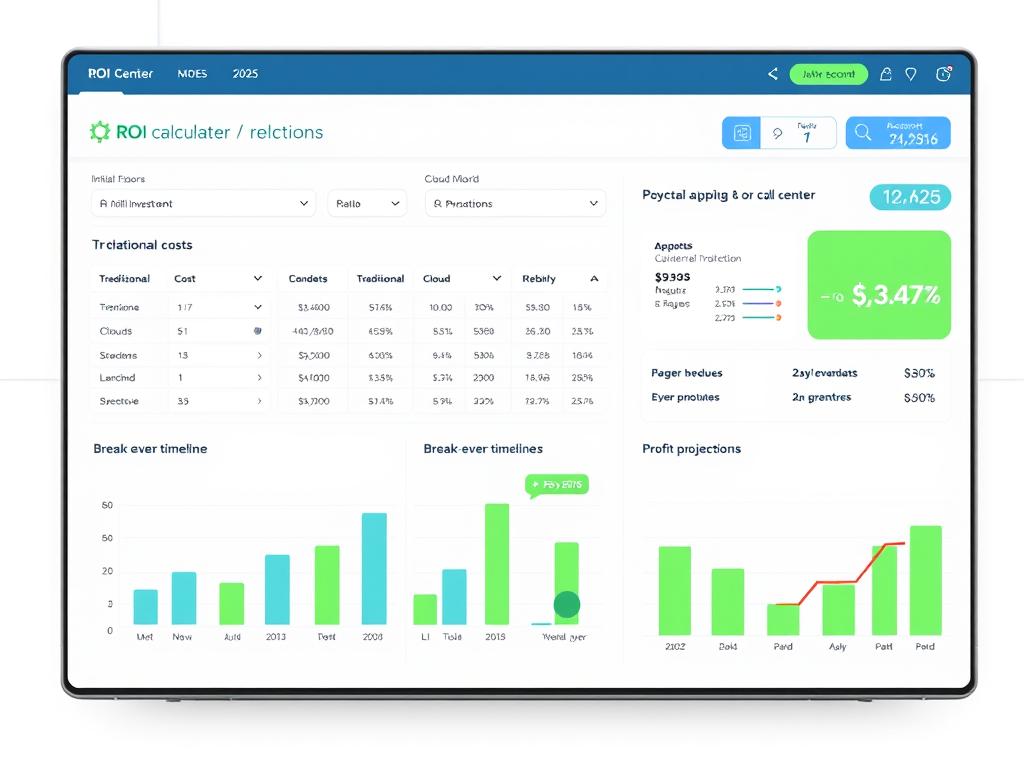
Interactive ROI calculator helps estimate returns for different call center investment scenarios
Cost Optimization Strategies
Smart approaches to maximize your budget efficiency:
- AI-Powered Workforce Optimization: Reduce staffing costs through intelligent scheduling
- Tiered Service Model: Offer premium support options for additional revenue
- Cloud Resource Elasticity: Pay only for what you use during peak periods
- Automation of Routine Tasks: Reduce agent time spent on administrative work
- Energy-Efficient Infrastructure: Lower utility costs while meeting sustainability goals
Plan Your Call Center Budget
Access our interactive cost calculator and financial planning templates to create accurate budgets for your 2025 call center setup.
Emerging Trends Shaping Call Center Setup 2025
Stay ahead of the curve by understanding the cutting-edge developments that will define successful call centers in the coming years.
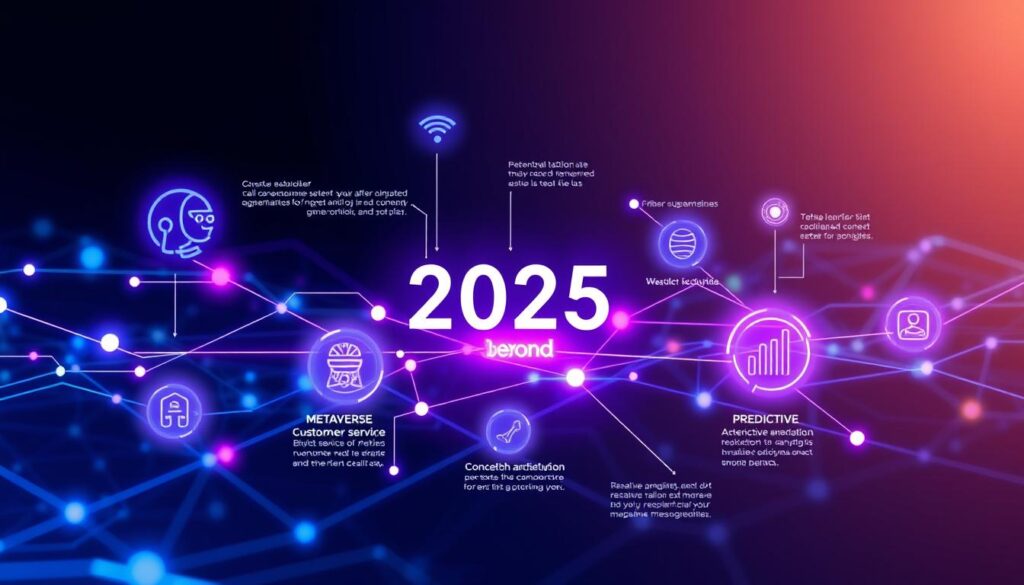
Emerging technologies and approaches that will define call centers beyond 2025
Metaverse Customer Service
Virtual reality environments are creating new possibilities for customer engagement:
- Immersive Support Environments: Virtual spaces where customers and agents interact with products
- Digital Twins: Virtual replicas of products for troubleshooting and demonstrations
- Avatar-Based Interactions: Personalized digital representations for both agents and customers
- Spatial Analytics: Understanding customer behavior in virtual environments
- Multi-Sensory Feedback: Haptic and audio cues to enhance virtual support
“The metaverse isn’t just changing where customer service happens—it’s fundamentally transforming how customers and brands interact. By 2025, we expect 15% of complex support interactions to take place in immersive environments.”
Hyper-Personalization Through Predictive Analytics
Advanced data analysis is enabling unprecedented levels of personalization:
Customer Insights
- Behavioral pattern recognition
- Emotional state prediction
- Lifetime value forecasting
- Churn risk assessment
- Preference anticipation
Service Delivery
- Proactive issue resolution
- Personalized self-service options
- Customized communication timing
- Channel preference adaptation
- Individualized offer generation
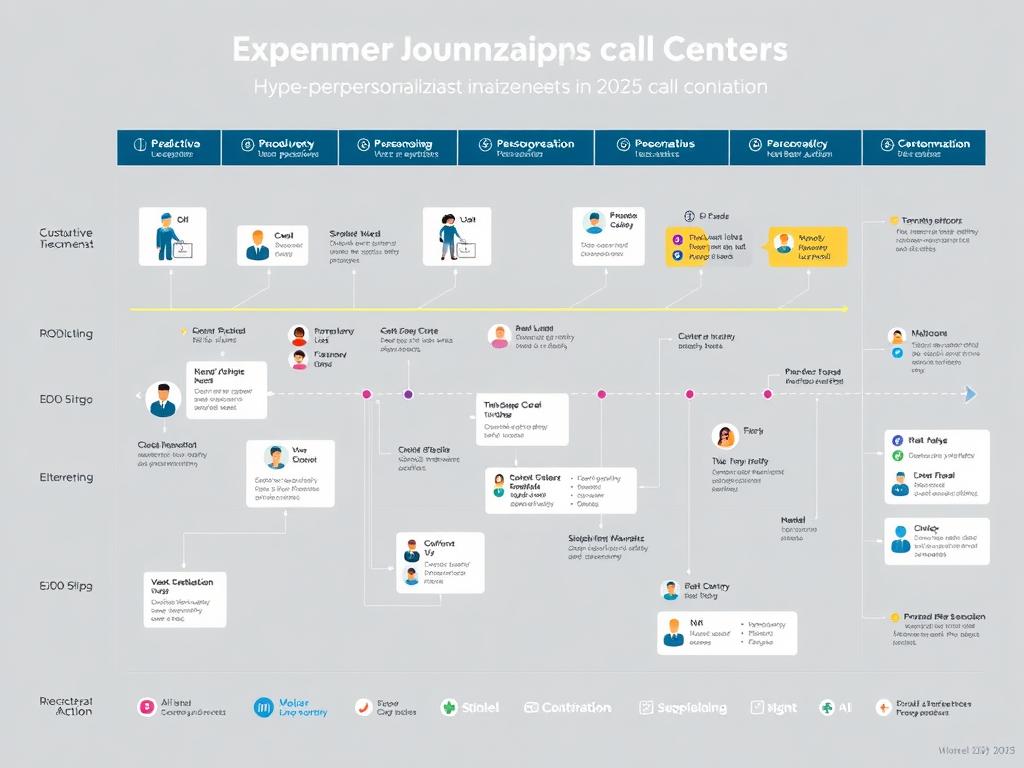
Hyper-personalized customer journeys adapt in real-time based on predictive analytics
Autonomous AI Agents
Self-directing AI systems are taking on increasingly complex customer interactions:
- Continuous Learning Capabilities: AI that improves through every interaction without human training
- Emotional Intelligence: Advanced sentiment analysis and appropriate emotional responses
- Complex Problem Resolution: Handling multi-step issues requiring judgment
- Human Collaboration: Seamless handoffs between AI and human agents
- Ethical Decision-Making: Built-in frameworks for responsible customer service
Future-Proof Your Call Center Strategy
Get our comprehensive Call Center Launch Roadmap PDF with implementation timelines, technology recommendations, and strategic planning templates.
Frequently Asked Questions About Call Center Setup 2025
Do I need physical office space for a call center in 2025?
Not necessarily. While traditional call centers operated from physical locations, the 2025 landscape offers multiple options. Cloud-based virtual call centers allow for fully remote operations with agents working from anywhere in the world. Hybrid models combine a small physical hub with remote agents. Your choice should depend on your specific business needs, security requirements, and target market. Many successful call centers in 2025 operate with minimal physical infrastructure, investing instead in robust cloud platforms and remote collaboration tools.
What is the typical ROI timeline for a new call center in 2025?
ROI timelines vary based on your call center model and focus. Cloud-based call centers typically see faster returns, with break-even points ranging from 12-18 months. Traditional on-premise centers may take 24-36 months to recoup initial investments. Factors affecting ROI include technology choices, staffing approach, and service offerings. Value-added services like premium support tiers can accelerate profitability. For most startups, a phased implementation approach with cloud infrastructure minimizes upfront costs and shortens the path to profitability.
How many agents do I need to start a call center in 2025?
The optimal agent count depends on your call volume, service hours, and complexity of interactions. With AI handling 30-40% of routine inquiries in 2025, human agent requirements are lower than in previous years. A small startup might begin with 5-10 agents plus AI support, while medium-sized operations typically require 20-50 agents. Workforce management tools can help you calculate precise staffing needs based on projected call volumes and handling times. Cloud-based models allow for flexible scaling as demand grows.
Launching Your Future-Ready Call Center in 2025
Setting up a call center in 2025 requires balancing cutting-edge technology with human-centered service. By following the blueprint outlined in this guide, you’ll be well-positioned to create a call center that not only meets today’s customer expectations but is adaptable enough to evolve with future trends.
Remember that the most successful call center setup 2025 strategies embrace flexibility, continuous learning, and a commitment to both customer and agent experience. Start with a clear vision, invest in the right technology infrastructure, build a skilled team, and implement efficient processes—all while maintaining compliance with evolving regulations.
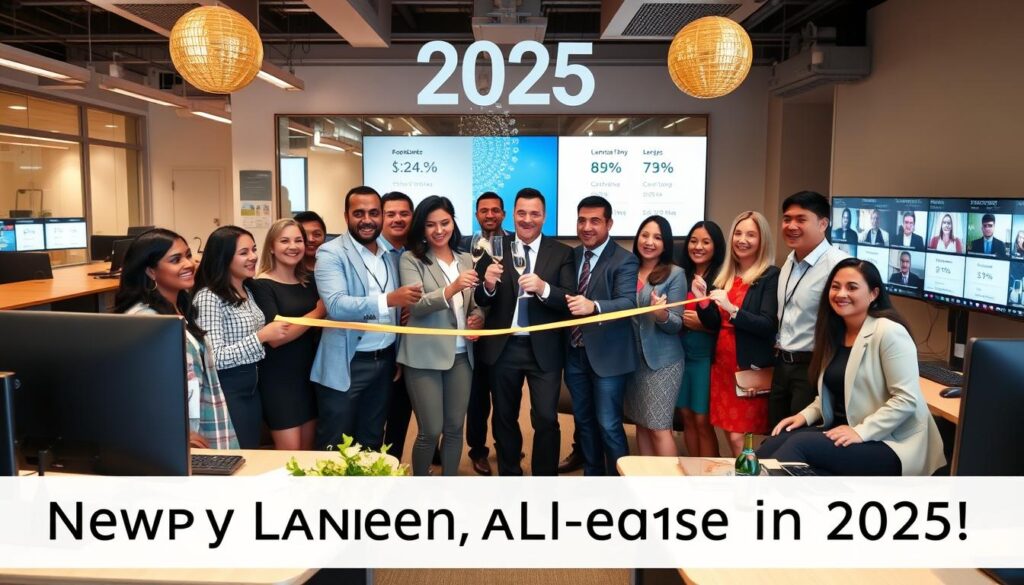
Celebrating the successful launch of your future-ready call center
The journey to establishing a successful call center operation doesn’t end with launch day. Continuous optimization, staying abreast of emerging technologies, and adapting to changing customer preferences will ensure your call center remains competitive and effective in the dynamic landscape of customer service.
Ready to Start Your Call Center Journey?
Download our comprehensive Call Center Launch Roadmap PDF with step-by-step implementation guidance, technology recommendations, and strategic planning templates.

The modern call center in 2025 combines AI technology with human expertise for optimal customer experience


